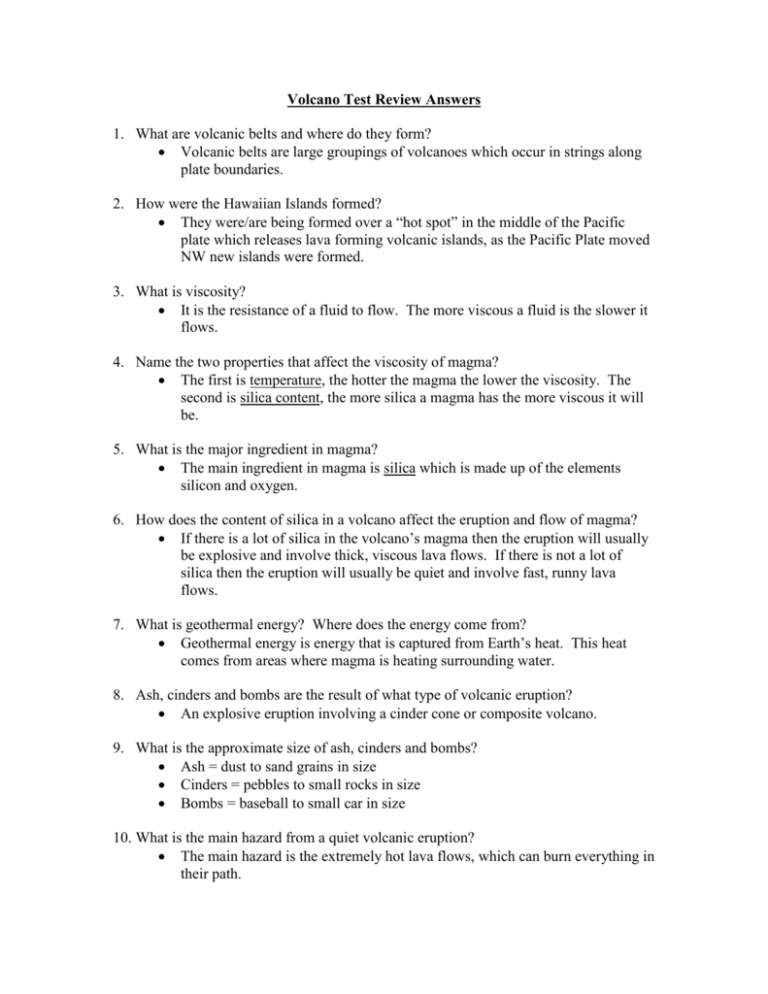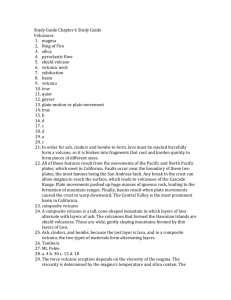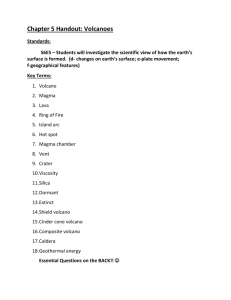Volcano Test Review Answers
advertisement

Volcano Test Review Answers 1. What are volcanic belts and where do they form? Volcanic belts are large groupings of volcanoes which occur in strings along plate boundaries. 2. How were the Hawaiian Islands formed? They were/are being formed over a “hot spot” in the middle of the Pacific plate which releases lava forming volcanic islands, as the Pacific Plate moved NW new islands were formed. 3. What is viscosity? It is the resistance of a fluid to flow. The more viscous a fluid is the slower it flows. 4. Name the two properties that affect the viscosity of magma? The first is temperature, the hotter the magma the lower the viscosity. The second is silica content, the more silica a magma has the more viscous it will be. 5. What is the major ingredient in magma? The main ingredient in magma is silica which is made up of the elements silicon and oxygen. 6. How does the content of silica in a volcano affect the eruption and flow of magma? If there is a lot of silica in the volcano’s magma then the eruption will usually be explosive and involve thick, viscous lava flows. If there is not a lot of silica then the eruption will usually be quiet and involve fast, runny lava flows. 7. What is geothermal energy? Where does the energy come from? Geothermal energy is energy that is captured from Earth’s heat. This heat comes from areas where magma is heating surrounding water. 8. Ash, cinders and bombs are the result of what type of volcanic eruption? An explosive eruption involving a cinder cone or composite volcano. 9. What is the approximate size of ash, cinders and bombs? Ash = dust to sand grains in size Cinders = pebbles to small rocks in size Bombs = baseball to small car in size 10. What is the main hazard from a quiet volcanic eruption? The main hazard is the extremely hot lava flows, which can burn everything in their path. 11. Describe how shield volcanoes form; include the type of eruption and lava. Shield volcanoes form from layers of quiet eruptions involving thin, fasterflowing lava which hardens into gently sloping mountains. 12. Describe how cinder cone volcanoes form; include the type of eruption and lava. Cinder cone volcanoes form from explosive eruptions involving ash, cinders and bombs which are deposited in layers around the vent of a volcano. 13. Describe how composite volcanoes form; include the type of eruption and lava. Composite volcanoes form from both quiet eruptions involving thin, fasterflowing lava and explosive eruptions involving ash, cinders and bombs at different times. 14. Name the type of rock that results from an explosive eruption. Pumice a very light rock with lots of air space. 15. What causes small earthquakes to occur before the eruption of a volcano? As the magma rises up from the ground (expanding) it causes the ground to move. 16. What is lava called bfore it reaches the surface? It is called magma (both are molten rock). 17. Volcanoes along the boundary of two converging oceanic plates may also form what feature? An Island Arc such as seen in Indonesia, the Carribean, and the Aleutian Islands. 18. Mountains that form because of volcanoes along a coastline occur at what type of plate boundary? A converging plate boundary where an oceanic plate is subducting (going under) a continental plate. 19. What is an active volcano? A volcano that is currently erupting or likely to erupt in the near future. 20. What is a dormant volcano? A volcano that is not currently active but may become active in the distant future. 21. What is an extinct volcano? A volcano that is inactive and very unlikely to ever become active again. 22. What is a crater? It is the bowl-shaped area that forms around a volcanoes opening. 23. What is a caldera? The large hole at the top of a volcano formed when the roof of the volcano’s magma chamber collapses. 24. What are some signs that a volcano may erupt? Increasing seismic activity around the volcano, release of volcanic gases and steam from the volcano or an increase in temperature of the ground water around the volcano. 25. What provides the force that causes magma to erupt to the surface? As the pressure drops, expanding gases in the magma cause the magma to rise (similar to the release of carbon dioxide from a shaken bottle of soda). 26. What is a substance that cannot be broken down into other substances? An element. 27. What is a substance that is chemically combined of two or more elements called? A compound. 28. What is the “Ring of Fire” and where is it located? A major belt of volcanoes which circle most of the Pacific Ocean (at the boundary of the Pacific plate). 29. What is a pyroclastic flow? The release of ash, cinders, bombs and volcanic gases during an explosive eruption.







